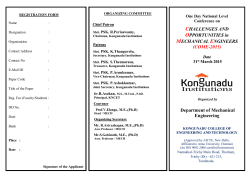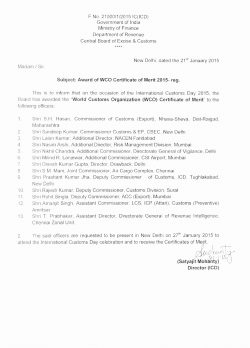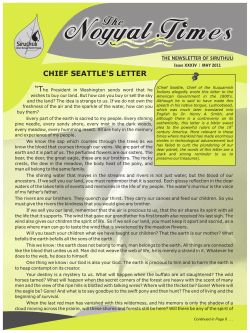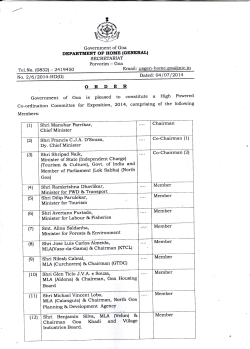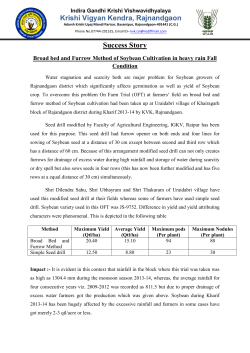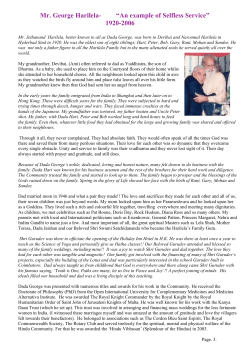
इंटरनेट मानक Disclosure to Promote the Right To Information
इंटरनेट मानक Disclosure to Promote the Right To Information Whereas the Parliament of India has set out to provide a practical regime of right to information for citizens to secure access to information under the control of public authorities, in order to promote transparency and accountability in the working of every public authority, and whereas the attached publication of the Bureau of Indian Standards is of particular interest to the public, particularly disadvantaged communities and those engaged in the pursuit of education and knowledge, the attached public safety standard is made available to promote the timely dissemination of this information in an accurate manner to the public. “जान1 का अ+धकार, जी1 का अ+धकार” “प0रा1 को छोड न' 5 तरफ” “The Right to Information, The Right to Live” “Step Out From the Old to the New” Mazdoor Kisan Shakti Sangathan Jawaharlal Nehru IS 9234 (1979): Methods for preparation of solid waste sample for chemical and microbiological analysis [CHD 32: Environmental Protection and Waste Management] “!ान $ एक न' भारत का +नम-ण” Satyanarayan Gangaram Pitroda “Invent a New India Using Knowledge” “!ान एक ऐसा खजाना > जो कभी च0राया नहB जा सकता ह” है” ह Bhartṛhari—Nītiśatakam “Knowledge is such a treasure which cannot be stolen” ( Reaffirmed 2003 ) IS : 9234 - 1979 Indian Standard METHOD FOR PREPARATION OF SOLID WASTE SAMPLE FOR CHEMICAL AND MICROBIOLOGICAL ANALYSIS Solid Wastes Sectional Committee, CDC 54 Rejresenting Members Ministry of Works & Housing, New Delhi Indian Sugar Mills Association, Calcutta Rajasthan State Agro Industries Corporation Jaipur ADVISER ( PHE ) SRRI M. ANAND SHRI S. C. ANAND Ltd, Y. K. LUMB ( Alternate ) Municipal Corporation of Greater Bombay F. A. ATTARWALA SHRI V. B. SHIRODKAR ( Alternate ) The Corporation of Calcutta, Calcutta SHRI P. K. BANERJEE CHOUDHURY Engineers India Ltd, New Delhi SHRI B. B. BRALERAO SHRI A. D. JALQAONKAR ( Alternate ) Steel Authority of India Ltd, Rourkela Steel SHRI R. K. BRAVE Plant, Rourkela SHRI T. A. SUBRAMANIAN ( Alternate ) Indian Paper Mills Association, Calcutta SHRI P. L. BURMAN Kaira District Co-operative Milk Processors SHRI T. C. CHANDARAN Union Ltd, Anand DR H. C. GUPTA ( Alternate ) Municipal Corporation, Ahmadabad SHRI A. H. GANDHI Municipal Corporation of Delhi SHRI J. D. GOEL Ministry of Agriculture & Irrigation ( Animal SHRI JWALA PRASAD Husbandry Division ), New Delhi Steel Authority of India Ltd, Durganur Steel SHRI J. N. MUEHERJEE I . Plant, Durgapur Central Fuel Research Institute ( CSIR ), SIIRI H. C. NANDI Dhanbad Khadi & Village Industries Commission, Bombay SHRI A. RAMA RAO All India Institute of Hygiene and Public Health, SHRI S. SUBBA RAO .Calcutta SHRI A. V. RAO ( Alternate ) SHRI B. V. ROTKAR Prevention of Water Pollution . Maharashtra Board, Bombay SHRI A. G. PANDIT ( Alternate ) SARI SHRI ( Continued on page 2 ) INDIAN 0 Copyright 1979 STANDARDS INSTITUTION This publication is protected under the Indian Copyright Act ( XIV of 1957 ) and reproduction in whole or in part by any means except with written permission ofthe publisher shall be deemed to be an infringement of copyright under the said Act. IS : 9234 - 1979 ( Continuedfrom page 1 > Representing Members DR A. ROY Indian Jute Industries Research Association, Calcutta Calcutta Metropolitan Development Authority, Calcutta _ Steel Authority of India Ltd, Bhilai Steel Plant, Bhilai SHRI P. K. SAHA SHRI DALJIT SINGH SHRI J. C. SEHGAL ( Alternate ) DR S. K. SINRA SHRI C. S. SRIDHARAN DR B. B. SUNDARESAN SHRI A. D. BHIDE ( Blteraate ) SHRI S. VENKATARAMAN DR G M. SAXENA, Director ( Chem ) The Tata Iron and Steel Co Ltd, Jamshedpur Indian Council of Agricultural Research, New Delhi National Environmental Engineering Research Institute ( CSIR), Nagpur King Institute, Madras Director General, ISI ( Ex-oficio Member ) Secretary SHRI A. K. BARL Assistant Director ( Chem ), ISI Panel for Methods of Sampling and Test for Solid Wastes, CDC54:P4 Members Steel Authority of India Ltd, Bhilai Steel Plant, Bhilai Indian Institute of Technology, Kanpur DR A. V. S. PRABRAK~RA RAO Indian Sugar Mills Association, Calcutta SHRIS.C.SHARMA of Agricultural Research, Indian Council SHRI C. S. ,SRIDRARAN New Delhi Indian Paper Mills Association, Calcutta DR D. C. TAPADAR SHRI A. SATYANARAYANA( Alternate) National Environmental Engineering Research SHRI V. P. THERGAONKAR Institute ( CSIR ), Nagpur SHRI S. K. TITUS ( Alternate ) King Institute, Madras SHRI S. VENKATARAMAN SHRI J. C. PAUL 2 IS : 9234 - 1979 Indian Standard METHOD FOR PREPARATION OF SOLID WASTE SAMPLE FOR CHEMICAL AND MICROBIOLOGICAL ANALYSIS 0. 0.1 This FOREWORD Indian Standard was adopted on 16 July 1979, after the draft Committee had been approved Institution Sectional Council. by the Indian Standards finalized by the Solid Wastes by the Chemical Division 0.2 The term ‘solid waste’ as used in this standard refers to: (a) raw refuse that is delivered to a processing facility for disposal, (b) residues of the incineration process, and (c) refuse in various stages of cornposting. metal, plastics, leather It is assumed that gross pieces of glass, ceramics, components, etc, have been removed before submission to the laboratory. 0.3 In the preparation of this standard considerable assistance has been chemical and microbiological derived from the publication ‘Physical, methods of solid waste testing’ issued by the US Environmental Protection Agency, USA, 1973. 1. SCOPE 1.1 This standard wastes for chemical prescribes a method and microbiological 2. PREPARATION OF SAMPLE for preparation analysis. of samples of solid FOR ANALYSIS 2.1 The three basic operations analysis products portions procedure compost mill or grinding, required to prepare the sample for detailed are drying, grinding or pulverizing, and mixing. The end of these operations should be so thoroughly homogenized that weighing 100 to 200 mg may be extracted for analysis. The for all types of organic materials is essentially similar, if samples have already been coarsely ground either in a hammerrasping device. The sample is dried before grinding. After it is subjected to mixing in a rotating mixer. the analyst should use gIoves, if possibIe of NOTE - When handling refuse, neoprene-coated canvas. He should also wear a face mask, such as a surgical mask, when preparing samples, especially when they are in finely divided form. .f’ 3 7, IS : 9234 - 1979 3. DRYING 3.1 A laboratory oven may be used for drying a small sample, and an Weigh a pan, transfer the material industrial oven for a large sample. to it and reweigh.. Note the mass of the sample and dry in an oven at 70 to 75°C for 24 hours if the material is combustible, otherwise dry at 105 f 1°C. Remove the sample and allow to cool, preferably in a Weigh, and again place in the oven for 1 to 2 hours. Repeat desiccator. the process of heating, cooling and weighing till the difference in mass between two successive weighings is less than one percent of the total previous loss in mass. Calculate the moisture content as percentage of the original mass. However, if microbiological tests are also to be conducted, drying shall be done at 40 to 50°C. 4. GRINDING 4.1 Waste material may contain glass, ferrous and non-ferrous metals, plastics, etc. Glass and ceramics may be separated by judicious sieving, plastics may be hand-picked as they are not degradable and interfere in the determination of carbon/nitrogen ratio, and ferrous metals may be After removal of these, proceed with removed by a strong magnet. grinding using a hammer-mill, grinding mill or pulverizer. 4.1.1 Procedure for Combustibles - Place the sample collection box under the grinding machine. Plug the lead into the power outlet. Open the cut-off in the dust collecting system. Oil the grinder bearings with engine oil. Put on personal safety equipment. Start the motor and feed the sample into the mill. Turn off grinder motor and turn off the blower. Clean out the grinder and add this material to the ground sample. NOTE - It is advisable to wear a transparent plastics face shield while feeding the material into the grinder. The analyst should not use his hand to help push material into the grinder past the feed slot. DO not open any grinding device while it is running. If the grinder clogs, turn off the motor before cleaning the apparatus. 4.1.2 Procedure for Compost - Put a 2-mm sieve into the grinding mill. Open the cut-off in the dust collection duct. Position the container under the delivery spout. Replace the 2-mm sieve with a l-mm sieve and regrind the sample. Brush out all inside surfaces of the mill into a separate container. Put this material through a micro mill. Add the product to the main sample. 4.1.3 Procedure for .Non-Combustibles - Adjust the movable pulverizer plate to give a maximum size of about 2 mm. Put the sample through the pulverizer. Screen the ground material through 2-mm and 250-micron 4 lS:9234-1979 sieves. The material sample. passing through 250-micron sieve is the required 5. MIXING 5.1 The final mixing or homogenization is accomplished by transferring the sample to a suitable container that is not more than half filled by it. Close the container tightly, position it in a rotating mixer and allow to Reduce the mixed sample in size if mix for not less than 2 hours. desired, by passing it through a sample splitter or by quartering. Weigh all metal, ceramic, plastics and glass removed during processing. 5 INTERNATIONAL SYSTEM OF UNITS ( SI UNITS ) Base Units QUANTITY UNIT SYMBOL Length metre m Mass kilogram kg Time second Electric current ampere A Thermodynamic temperature kelvin K Luminous Amount intensity of substance SupplemAary candela cd mole mol Units UNIT QUANTITY SYMBOL Plane angle radian rad Solid angle steradian sr Derived Units UNIT QUANTITY DEIPINITION SYMBOL Force newton N 1N = 1 kg.m/s* Energy joule J IJ = Power watt W 1w = 1 J/s Flux weber Wb 1 Wb - Flux density tesla T 1T 1 N.m 1 V.s = 1 Wb/ms Frequency hertz HZ 1 Hz = 1 c/s (s-1) Electric conductance siemens S 1s = 1 A/V Electromotive volt V 1V = 1 W/A Pascal Pa 1 Pa = 1 N/m2 Pressure, stress force
© Copyright 2025
